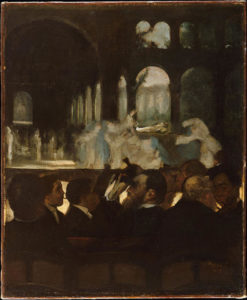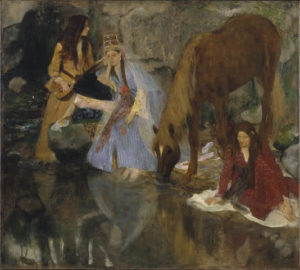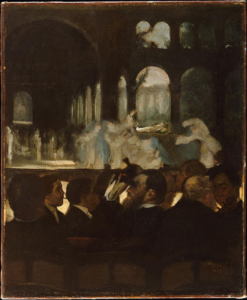
When we think of Degas, we think immediately of ballerinas and that is the subject of the beautiful exhibition currently at the Musee d’Orsay which travels next year to the National Gallery in Washington, D.C. When I think of Degas, I also think of two other women’s occupations.

One is the modiste, (milliner) who created the beautiful hats worn by elegant women in the 19th century. The other is the repasseuse, (clothes ironer), who Degas depicts either in the process of doing back breaking work or yawning and stretching. Degas’ paintings, drawings, prints and statues of ballerinas seem either to be like his depictions of milliners or his depictions of ironers. On the one hand, when we sit with him in the audience of a ballet, we see a glittering spectacle, the scenery, the costumes, the ballerinas dancing in perfect unison, the orchestra in the pit below accompanying them. And when we go backstage with Degas, we see the dancers working, stretching. yawning. The stage, like the milliner’s shop, shows us the finished piece, the performance. The backstage images, seem, to me, like the paintings of ironers working, an intrusion into a private space.
Like the Impressionists, Degas painted the world around him, and for him, like them, no subject was too ordinary or too insignificant. But Degas’ world was the artificial world of the theater, the opera, the ballet and not the natural world of the Impressionists. And while the impressionists often painted ‘en plein air’ Degas sketched when he was at the opera house but he painted in his studio. Degas said that his subject was movement, for him the ballerinas were an opportunity to depict movement. He was interested in the photographic experiments of photographers like Muybridge who sequenced the movements of runners and horses. Degas’ double width canvases show the same sort of progression of female dancers whose movements naturally follow one another. Degas seems also to be channeling the 18th century artist Watteau.

In addition to Degas’ work, the exhibition presents the history of the Paris Opera Ballet, the world’s first professional ballet company (founded in the 17th century). We learn about the Salle Le Peletier, where Degas first painted musicians and ballerinas and which was the home of the Paris Opera from 1821 until it was destroyed by fire in 1873. Through drawings and moquettes,we learn about the building project of the Opera Garnier which opened in 1875. Models of stage sets enhance our appreciation of the productions that have been mounted there. It is a rich and varied exhibition and well worth exploring.
Long before there was an ‘# me too’ movement, Edgar Degas’ sketches, drawings, paintings and sculptures of ballerinas bothered me. Depictions of the private, awkward moments of a ballerina’s professional life, as she stretches, bends and rubs her sore limbs and feet. Who let him in, I wanted to know. Those images are invasive, but they are not the most disturbing. The really disturbing ones are of ballerinas going over their steps in practice rooms, while men, wearing business suits, sit idly by, on chairs, watching them. I bristled as I looked at these men looking, always wondering why they were allowed to enter into what should have been private spaces reserved for the dancers. Those questions seem even more pertinent with our current crop of dirty old (or young) men. Donald Trump, to take one example, thought that when he bought the rights to the Miss America Beauty Pageant, that he also bought access to the dressing rooms while young beauty pageant hopefuls changed costumes. In the case of Degas’ old men, turns out that is exactly what they had bought. By purchasing subscriptions to the opera, these wealthy aristocrats and financiers (abonnés) had bought access to the backstage, specifically to the young, vulnerable, ballerinas, the corps de ballet (petits rats) . These girls, many of whom had joined the Opera as young as six years old, worked to help support their families. Like factory workers, they worked six days a week. Poorly paid, they were easy prey to the advances of wealthy old men. Then, as now - or at least recently (think Harvey Weinstein) if any of the dancers dared refuse a rich man’s advances, it could mean the end of a dancer’s careers since it was these same men who underwrote the opera’s operating budget. With one word, they could end a young dancer’s career. Degas wasn’t wealthy enough to have such a pass, so he borrowed them from his wealthy friends and what we get is behind-the-scenes views of dancers practicing and lecherous male subscribers, watching. Degas isn’t judging anyone, he is making art. Indeed some of these young girls became his private models.

Okay, so now you know. And yet after having said all that, I must tell you that the exhibition ‘Degas at the Opera’ now on at the Musee d’Orsay is lovely and you should definitely go see it. One of the first paintings in the exhibition, from 1868, is a portrait of the ballerina, Mlle Fiocre. The painting doesn’t work, it is a hodgepodge of portraiture, history painting, orientalism and landscape, with a pair of ballet slippers set incongruently on the grass next to a horse. But just two years later, Degas has become Degas.
 The portrait of his friend, Desire Dihau, a bassoonist in the Paris Opera orchestra, depicts the musician playing his bassoon, surrounded by fellow musicians. Above and behind is the stage of dancing ballerinas - all truncated legs and tutus.
The portrait of his friend, Desire Dihau, a bassoonist in the Paris Opera orchestra, depicts the musician playing his bassoon, surrounded by fellow musicians. Above and behind is the stage of dancing ballerinas - all truncated legs and tutus.  A third painting, from 1871 has so much going on, you might miss the man who caught my eye immediately. In the background of ‘The Ballet from Robert le Diable’ is a huge stage set, the orchestra is in the foreground. In the immediate foreground, is a man with binoculars looking away from the stage, towards the audience.
A third painting, from 1871 has so much going on, you might miss the man who caught my eye immediately. In the background of ‘The Ballet from Robert le Diable’ is a huge stage set, the orchestra is in the foreground. In the immediate foreground, is a man with binoculars looking away from the stage, towards the audience. The idea of looking at someone besides the spectacle is an image that appears in the art of Degas’ contemporaries. One such painting is by Mary Cassatt, Degas’ dear friend and fellow painter. In it, a woman at a theatrical performance looks at a performance through binoculars, in the distance a man in the audience trains his own binoculars on the woman herself.
The idea of looking at someone besides the spectacle is an image that appears in the art of Degas’ contemporaries. One such painting is by Mary Cassatt, Degas’ dear friend and fellow painter. In it, a woman at a theatrical performance looks at a performance through binoculars, in the distance a man in the audience trains his own binoculars on the woman herself. Like the Impressionists, Degas painted the world around him, and for him, like them, no subject was too ordinary or too insignificant. But Degas’ world was the artificial world of the theater, the opera, the ballet and not the natural world of the Impressionists. And while the impressionists often painted ‘en plein air’ Degas sketched when he was at the opera house but he painted in his studio. Degas said that his subject was movement, for him the ballerinas were an opportunity to depict movement.
He was interested in the photographic experiments of Muybridge and others who sequenced the movements of runners and horses. Degas’ double width canvases show the same sort of progression of female dancers whose movements naturally follow one another.
Degas seems also to be channeling the 18th century artist Watteau.
In addition to Degas’ work, the exhibition presents the history of the Paris Opera Ballet, the world’s first professional ballet company (founded in the 17th century). We learn about the Salle Le Peletier, where Degas first painted musicians and ballerinas and which was the home of the Paris Opera from 1821 until it was destroyed by fire in 1873. Through drawings and moquettes,we learn about the building project of the Opera Garnier which opened in 1875. Models of stage sets enhance our appreciation of the productions that have been mounted there. It is a rich and varied exhibition and well worth exploring.
Tour the Exhibit with Dr, Beverly Held
Limited to 1-4 persons
1-2 persons 350 euros (admission included)
3-4 persons 500 euros (admission included)
Reservations: Terrance@paris-expat.com


4 comments
Karen Marin October 29, 2019
Interesting to start the article showing two paintings that are not in the exhibit!
Frances Hurwitz October 29, 2019
I am most impressed by Beverly Held’s review of the Degas Exhibit. Familiar as I am with his pairings of and sculptures of the ballerina , portrayed with such ethereal quality, her prescient comments bring another perspective to my mind especially as it relates to current times and personalities and the Me Two movement. I look forward to reading more such reviews of this educated reviewer in the future. Bravo !!!
Julia Frey October 31, 2019
Lovely review, full of contextual information and most interesting parallels with the problems of today's woman performers (and others). Eager to see in person the painting of the horse onstage! I hope Beverly Held will write many more reviews. (BTW, what looks like an editing glitch somehow allowed a couple of repetitions to slip into the text.)
Pingback: Toulouse -Lautrec at The Grand Palais – Terrance – Your American friend in Paris